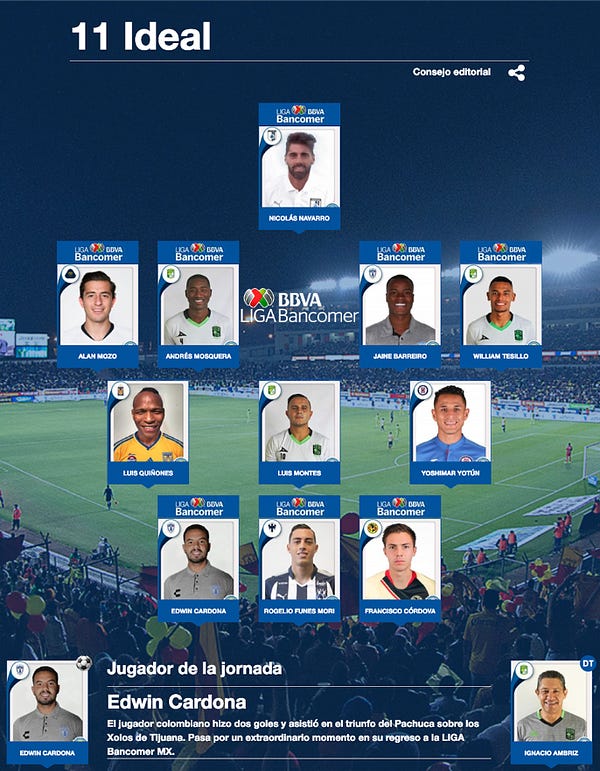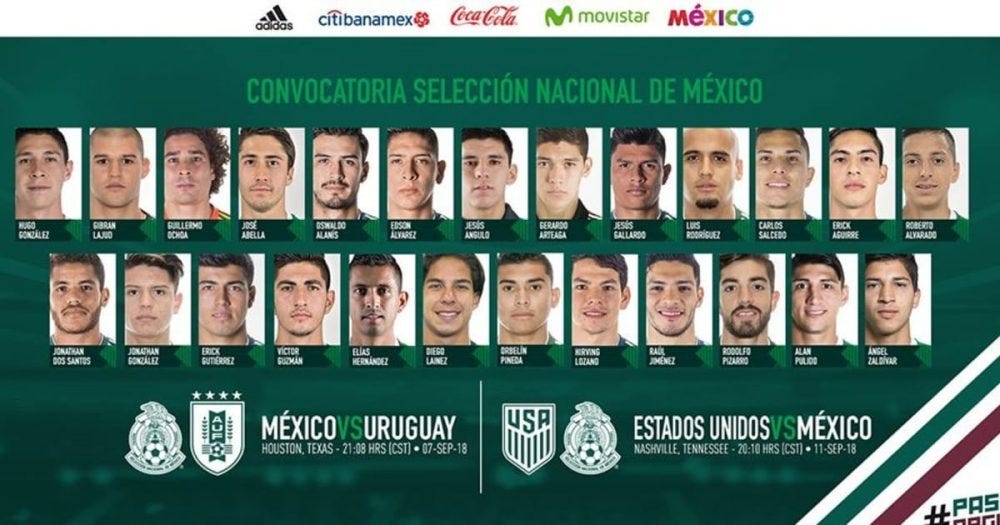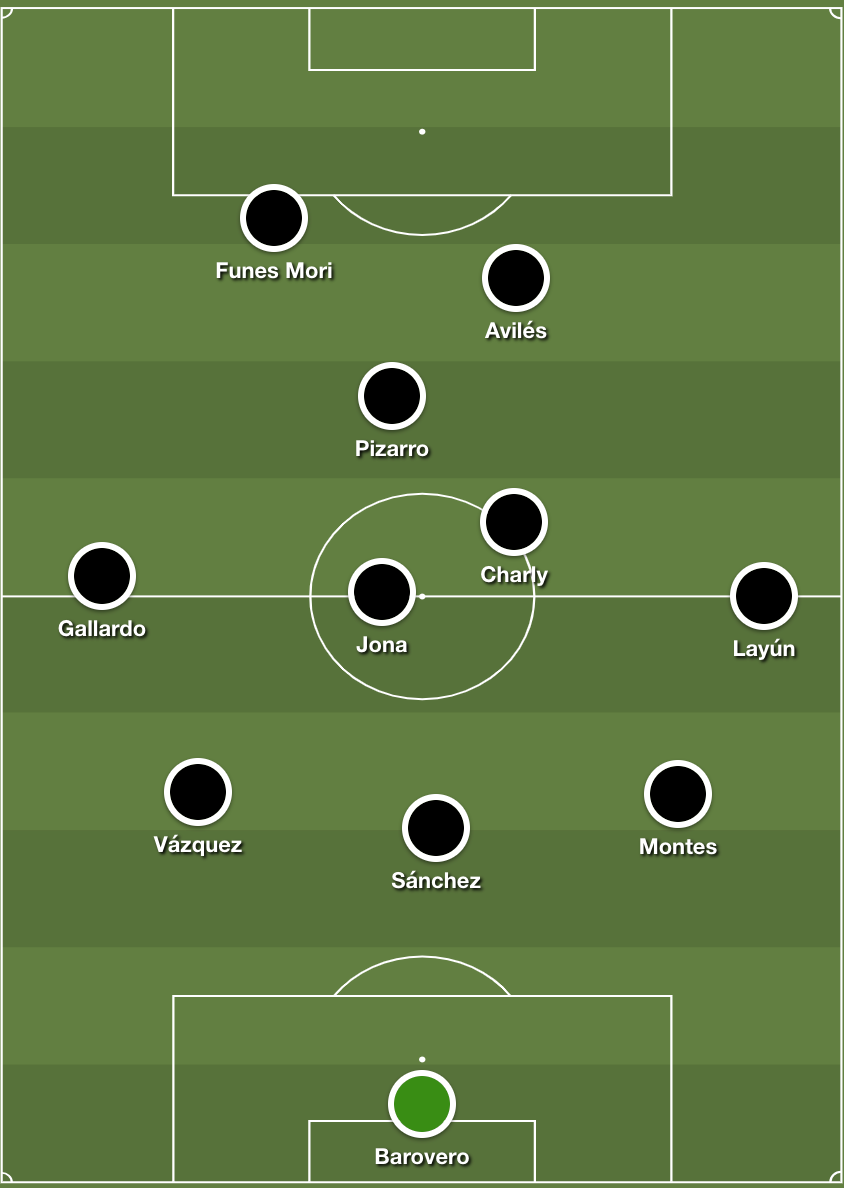The topics for this week’s newsletter include:
Sebastián Córdova
The new road, with El Tata in command
Now that we’re aware that the Champions League quarterfinals look like this:
Barça vs. Manchester United; FC Porto vs. Liverpool
Manchester City vs. Tottenham; Juve vs. Ajax
Time to read on these Mexican football topics.
How Córdova is winning a starting role with América
After last season’s title win, Miguel “Piojo” Herrera has the right to act patient and, to a certain degree, test things out with the team’s XI, as new faces integrate to the squad. This season, players like Nicolás Castillo, Nicolás Benedetti and even Jérémy Ménez (the Frenchman was out for close to a year) represent the change taking place at the club. From them, a more explosive type of football is expected, however, the last three league results since the 3-0 win over Lobos BUAP, have said the opposite. What the new faces are offering is nowhere close to explosiveness.
Strikers like Castillo, Henry Martín and Roger Martínez have to be more clinical in front of goal, while questions are starting to arise on whether Mateus Uribe is ready to maintain his role in the midfield, which would mean that Edson Álvarez will be slotted back in the defense. But that performance in the final against Cruz Azul is still very present, and the options still make sense to keep him in the midfield as Álvarez looks to consolidate himself as a serious defensive midfield option for Gerardo “Tata” Martino’s México. But that’s another story.
In América, there are players who come up from the academy and are meant to just flourish in the first-team. Luckily for Herrera’s side, he’s benefited from cases like Álvarez and Lainez. And although Jorge Sánchez was brought up in Santos’ excellent academy, his presence in the team during the last months has been invaluable. In Mexico, there’s no full-back right now who can play both full-back positions with so much class and maturity. Mexican youngsters have made a big difference in the last months for América’s success.
Now, Sebastián Córdova’s name can be added to this list that includes Álvarez, Lainez and Sánchez’s names. Without Córdova’s presence in these last three league games against Morelia (2-2), Necaxa (1-3 loss) and Puebla (1-0 win), there would be more questions than answers at Coapa. Córdova’s presence has offered unexpected benefits to América’s tactical needs.
Córdova’s ability to appear in various midfield zones make him an important contributor, as his ability to use both his left-foot and right-foot to create danger. What he offers to Herrera is similar to what Uribe can offer, which is a midfielder who’s more of a llegador. He has the ability to run into the box and become another scoring option, and his ability to associate with the full-backs, who also provide more volume to the attack, can’t be ignored.
His second half performance in the 1-0 win over Puebla got him a place in Liga MX’s Week 10 Best XI:


But what was interesting to take away from the 3-1 defeat against Necaxa is that after Herrera decided to move Córdova from the central midfield zone, where he had plenty of liberty, to the left-flank, his contributions in the offensive end dropped. Just to get an idea, in the games that he scored goals — vs. Morelia and vs. Puebla — Córdova didn’t create a single key pass, according to SofaScore. But in that game against Necaxa, he created three key passes.
It will be interesting to see how Herrera handles himself in the following weeks, especially if players like Benedetti and Ménez, who have yet to fulfill expectations, are given more minutes than Córdova. Because with Uribe, the situation is different. The Colombian midfielder has already proved how important he can be for las águilas’s offensive needs. His recent call-up to the national team could help him build on a momentum that América will benefit from in the next weeks.
There’s something, though, with América’s recent canteranos. Alvarez’s goals in the finals (vs. Cruz Azul and vs. Tigres), Lainez’s overall performance in that semifinal series against Pumas. These players feel the colors, understand the position they’re in and are vastly skillful to play in different positions. Córdova has seen how Álvarez has battled to win a starting role at América, and Álvarez has done it by playing in multiple positions, making him into a versatile option.
If there’s something these last games have shown is that Córdova has the skill set to play in various zones of the midfield; it’s just a matter of getting more chances, so he can expand his level of play.
The questions and early conclusions from Tata’s March roster
When I realized that Gerardo “Tata” Martino agreed to become México’s national team manager, I felt quite surprised and astonished. Here we have a manager that has seen it all in the game — from coaching FC Barcelona in the Champions League to coaching Messi and Argentina; from coaching Newell’s, the club of his life, in the Copa Libertadores semis to coaching a brand new football club in Georgia and winning a league title along the way.
But of all his achievements, the one that captures most attention in México is what he achieved with Paraguay’s national team in 2010, and how he was able to lead La Albirroja to the World Cup quarterfinals. His ability to help pave a way that led Paraguay to a top eight finish is a remarkable story and is something Mexican football covets in order to continue growing as a football nation.
After two great years at Atlanta, Martino is about to start a new journey, in which there are already doubts on how much patience and peace he will have as he begins to make his test runs. Wish that in México it would be easy to say, “Just let him work and do his magic!” But I’m afraid it just doesn’t happen that way because of X, Y and Z.
The observations that come from this roster can go in the direction of emphasizing how important the European legion will continue to be for El Tri. Even those who have already played in Europe and are now in Liga MX or MLS like Carlos Salcedo, Miguel Layún, Raúl Gudiño and Jonathan dos Santos continue to be an integral part of the roster. In a different category, but similar to those mentioned, you can put Charly Rodríguez, who played a full season with CD Toledo in Spain’s Segunda B. Rodríguez played several games against Real Madrid Castilla, which at the time was coached by Santiago Solari.
They can also go in the direction on how there’s a special attention deposited on the young talent coming up. For example, let’s take a look at Tuca’s first-call-up for the friendlies against Uruguay in Houston and the USMNT in Nashville:

It’s important to note that although Salcedo and Rodolfo Pizarro were on the initial roster, they didn’t make the trip to the United States due to injury. Of the 29 names on Tata’s first roster, there are 13 names here: Guillermo Ochoa, Edson Álvarez, Jesús Gallardo, Chaka Rodríguez, Roberto Alvarado, Salcedo, Jonathan, Erick Gútierrez, Víctor Guzmán, Diego Lainez, Chucky Lozano, Raúl Jiménez and Pizarro.
Players like Lainez, Alvarado, Lozano, Guzmán, Guti, Edson, Gallardo, Salcedo and Pizarro represent a pathway to change because it’s a mixture of players who are barely having their first taste of the senior side, and players who already have one World Cup under their belt. It’s an ideal mix and gives Martino a solid pool to work with in the following years. Also, what this list by Tuca suggests is that there’s still a strong group of players who will be making serious moves in the following months, as they seek to break into Tata’s squad. Those players are Gerardo Arteaga, Jesús Angulo, José Abella, Erick Aguirre, Jonathan González and Orbelin Pineda.
Now back to this month’s list.
Of the 29 players on the roster, sixteen have at least one World Cup in their bag. Néstor Araujo should already have one World Cup in his résumé, as Chapito Montes, but injuries at AT&T Stadium crushed their goals. Players like Alexis Vega and Rodríguez can be added in the same boat as Lainez, Alvarado, Guzmán, Pizarro, Jorge Sánchez and Gudiño, who are trying to prove that they deserve to be in Martino’s proceso from start to finish.
Without a doubt, the group of Gallito Vázquez, Chapito and Isaác Brizuela is the one in the middle between that young generation and that other group of players with experience playing in Europe. They’re kind of in the middle ground, with the possibility of offering an unexpected surprise factor. What they all have in common is that they were in Miguel “Piojo” Herrera’s 23-man 2014 World Cup roster. Chapito got injured several days from flying to Brazil and needed to be replaced, Gallito started all the World Cup games, except the big one against the Netherlands due to suspension, and Brizuela didn’t see a single minute but made the trip.
Their participation in the following games will depend on the type of shape and style Martino will want to employ.
On paper, Brizuela has more competition to get minutes because he will be competing with the likes of Tecatito Corona, Chucky, Lainez and Alvarado.
Gallito could get a start, especially in a starting line-up that requires a sole defensive midfielder or two in a 4-2-3-1, 3-5-2, 3-4-3 or 4-4-2.
With Chapito, you kind of get the sense that he could make it work in any zone of the midfield, but if he’s told to play deep, he’ll need someone else besides him to help contend the opponent. His distribution, at times, is what a no. 10 offers. Other players on this list who fit this description are Lainez, Alvarado, Pizarro and even Guti, whose first days at PSV have included playing a no. 10 type of role.
Rayados lost to Atlanta 1-0 on Wednesday, but the tactical intention throughout the 90 minutes was interesting to observe.
The formation had a shape that looked something like this, especially when going forward:

It’s true that in defensive work, Gallardo and Layún were basically in the same line as the central defenders. And to be honest, what Gallardo and Layún offered offensively was very poor for their standards, had they been a bit more alert in the final third during those first 45 minutes, Rayados might have scored a goal at Mercedes-Benz Stadium.
By the way, Pizarro had a special game.
For Pizarro, the call-up is coming at a moment when his game is elevating, and competition for playing time will be fierce once Maxi Meza begins to show more consistency with his play.
Will Martino return to those days of the backline of three, and how will the shape look like? Because having five options to track back and defend doesn’t necessarily mean to park the bus. Look at Real Betis and how they’ve employed a backline of three, which includes three central defenders that end up having a lot of touches on the ball in the opponent’s territory.
When you speak with people that observe the Mexican game, many will state, “los centrales mexicanos siempre son de buen pie,” Mexican center-backs are good with the ball on their feet. If Martino decides to go with something similar to a 3-5-2, how could the XI look like?
Here’s a possibility.

Notice I left one question mark, I’m unsure who can go there because you can go with the option that fulfills the job of a no. 10 like Pizarro, Lainez, Alvarado or Chapito. But you can also just select Tecatito, who’s one of Mexico’s most in-form attackers, and the shape of this line-up could turn into a 3-4-3, with Raúl as the striker and Tecatito and Chucky on the flanks. Another option is to include Guzmán, which becomes another scoring threat but is also good on tracking back and supporting the midfield in defensive plays.
Imagine this same formation and deciding to put Sánchez as LWB and Tecatito as RWB. The case of Tecatito as RWB could turn into a possibility in those games where the opponent just sits back; we’ll have to wait and see.
As you’ve seen, there are many options on the table. We didn’t even go over the possibility of the 4-4-2 with Raúl and Chicharito up top, or the 4-3-3, which continues to be a strong possibility and something that could work with El Tri, as long as it gets repetitions in order to solidify the influence of the midfielders and making all the pieces work. In a 4-3-3, the influence of the full-backs has to be visible, and in recent years, El Tri has struggled in finding the right fits.
Tata, do your magic.




